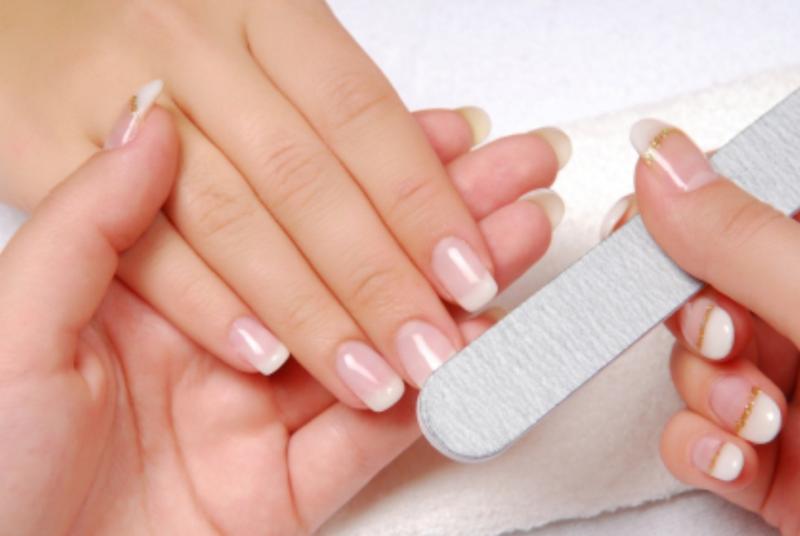I. Clean up your nails.
Use a cotton ball lightly soaked in nail polish remover to remove any nail polish currently on your nails. Gently trim your nails with nail clippers until your nails are at your desired length. Then use a nail file to smooth out rough edges and shape your nails.
- You can also push back your cuticles using a rounded manicure stick. This will help elongate your nail beds, so your nails look longer.
- Alternatively, you can push back your cuticles using your thumbnail on your opposite hand.

II. Apply a clear base coat.
Paint on a thin, clear, base coat to all of your nails. A clear base coat protects your nails from getting stained by colored polishes and helps extend your manicure by decreasing the prevalence of chips in your nail polish.
III. Apply your base color coat.
With ombré nails, your base color is usually a white polish or the lightest color you plan to use for the ombré effect. A white polish will help colors seem more vibrant, but using the lightest of your planned ombré polishes will give a softer, more subtle ombré effect. Paint this background color on all of your nails.
- For an opaque base, paint two coats of your base color. Allow the first coat to dry completely before adding the second coat.
- To help your nails dry faster, it’s better to paint two thin coats of polish rather than one, thick and heavy coat of polish.
IV. Paint your ombré colors onto a makeup sponge.
Paint your ombré colors in straight, horizontal lines side-by-side across a small makeup sponge. The area of the sponge you paint should relatively be the same width as your nail. Start by painting a line across the width of the sponge with the lightest color of nail polish. Then paint with the next darkest color underneath the first color. Finally, paint the darkest color of polish underneath the second line of polish. Be sure that all the colors are painted right next to each other with no exposed sponge between the colors. Paint a couple coats of polish onto the sponge for each color so the polish is wet enough to stamp onto your nail.
- Normally, two or three colors are used to create the ombré effect, but you can experiment with different colors and combinations to see what you like best.
- It may help to dip the makeup sponge in water first before painting on the colors. Dip the makeup sponge into water. Wring out the sponge until approximately 80% of the water is removed. Then paint on the nail polish colors.
- Dipping the sponge in water will prevent the sponge from absorbing too much polish and having the polish dry up too quickly on the sponge.
Expert tip
Overlap two colors on a makeup sponge. Marta Nagorska, a nail art blogger, says: “Start by applying a base coat, followed by a white polish which helps bring out the colors you’re using for the ombre. Lay two colors on a triangle makeup sponge so that they’re almost overlapping and then press the sponge onto your nail a few times. Continue pressing the sponge until it’s blended enough for you. It’s very important to finish with a top coat which helps with any bubbles that can form.”
V. Stamp the polish onto your nails.
Stamp the polish onto your nail by pressing the sponge (with the polish side down) on top of you nail repeatedly, lifting the sponge away every couple of stamps to check and see if the ombré is dark enough and to your liking.
VI. Roll the polish onto your nails.
Roll the polish onto your nails by placing the side edge of the sponge next to the side of your nail. Slowly roll the sponge (with the polish side down) over your nail to the other side of your nail. Do this repeatedly to darken the polish colors and increase the ombré effect.
- This process will transfer some nail polish onto your skin surrounding your nails. To prevent this you can edge the skin around your nails with a thin layer of petroleum jelly or place tape on the skin surrounding your nails. Otherwise; you can use nail polish remover to clean the sides of your nails later.
- There is a lot of freedom with how you transfer the paint to your nail. You can adjust the placement of the sponge (stamping vertically on the length of your nail, tilting the sponge to specifically stamp on a certain color) to make your ombré effect unique and original.
VII. Reload the sponge.
When you have finished the ombré effect on one nail, reload the polish onto the sponge, so the ombré colors remain wet and vibrant. Paint the nail polish colors in the same fashion as before, lining the sponge with the lightest color and moving down to the darkest. Make sure all the polish colors are side-by-side touching each other.
- Keep in mind, if you try to ombré you nails with a sponge that isn’t damp enough with polish, the dry sponge can actually pull off your base color coat and ruin your polish.
- If you stamp or roll your nails quickly, you most likely only need to add polish to the sponge for every other nail.
VIII. Apply a topcoat.
Once you have given all of your nails adequate time to dry (about 10-15 minutes), add a top coat of clear polish to your nails. You might want to consider doing two coats of a top coat to smooth out your nails, since the sponging makes the surface of your nail a little stippled and bumpy.

IX. Clean up the skin around your nails.
Use a small paintbrush or Q-Tip dipped in nail polish remover to swipe along the edges and cuticles of your nails.
- The cotton on the Q-Tip will help rub off polish on the skin, whereas the paintbrush can be more exact in removing excess nail polish.
